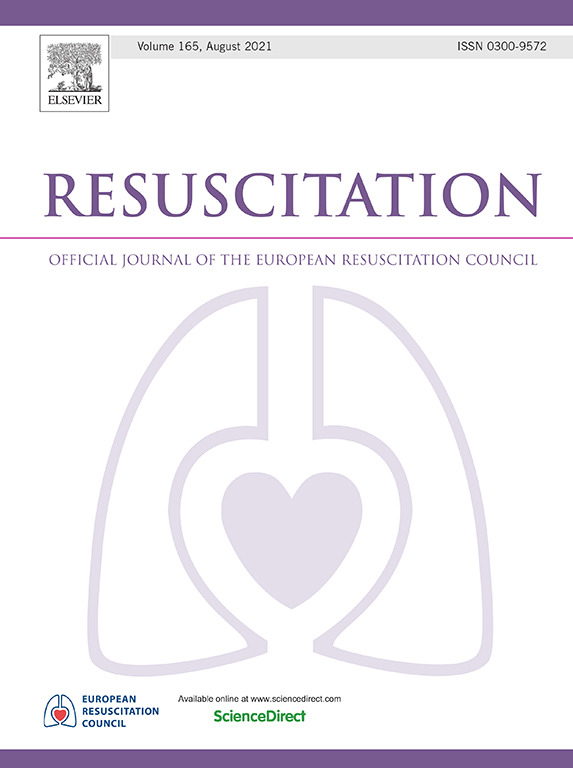早产新生儿在产房开始稳定时的最佳氧气浓度:随机对照试验
IF 6.5
1区 医学
Q1 CRITICAL CARE MEDICINE
引用次数: 0
摘要
理由:在产房(DR)中稳定早产新生儿的初始吸入氧饱和度(FiO2)的理想选择尚未确定:比较不同初始 FiO2 对新生儿的影响:在这项开放标签、评估者盲法、平行组随机对照试验中,150 名新生儿被分配到使用 60 %(n = 75)和 30 %(n = 75)的 FiO2 开始 DR 稳定,然后滴定到外周血氧饱和度 (SpO2) 目标。主要结果是新生儿在出生后 5 分钟内达到目标 SpO2 ≥ 80% 的比例。次要结果包括分钟特异性SpO2、10分钟前的心率(HR)和FiO2趋势、1小时后的区域脑氧合(CrSO2)、表面活性物质和咖啡因的需求、呼吸支持持续时间、院内不良事件、死亡率和住院时间。使用Stata 15进行意向治疗分析:5分钟时SpO2≥80%的新生儿比例,60%为58人(73.3%),而FiO2为30%的为38人(50.7%)[相对风险(95%置信区间)为1.53(1.18,1.97);60%组的P 2和FiO2显著高于60%组,HR趋势相当。在 CrSO2、呼吸支持、表面活性物质和咖啡因的需求和持续时间、不良事件(包括死亡率)的发生率以及住院时间等方面均未观察到差异:结论:与 30% 相比,在初始 FiO2 为 60% 的稳定状态下,早产新生儿 2 ≥ 80% 的人数明显较多,且分钟特异性 SpO2 趋势较高。本文章由计算机程序翻译,如有差异,请以英文原文为准。
Optimum oxygen concentration for initiation of delivery room stabilization in preterm neonates: A Randomized Controlled Trial
Rationale
The ideal choice of initial fraction of inspired oxygen (FiO2) to stabilize preterm neonates in the delivery room (DR) is not well-established.
Objective
To compare the effects of different initial FiO2 in neonates < 34 weeks’ gestation requiring respiratory support for DR stabilization.
Methods
In this open-labeled, assessor-blinded, parallel-group randomized controlled trial, 150 neonates were allocated to initiate DR-stabilization with 60 % (n = 75) versus 30 % (n = 75) FiO2, followed by titration to peripheral oxygen saturation (SpO2) targets. The primary outcome was the proportion of neonates achieving a target SpO2 of ≥ 80 % at 5 min of life. Secondary outcomes were minute-specific SpO2, heart rate (HR) and FiO2 trends till 10 min, regional cerebral oxygenation (CrSO2) at one hour, need for surfactant and caffeine, respiratory support duration, in-hospital adverse events, mortality, and duration of hospitalization. Stata 15 was used for an intention-to-treat analysis.
Results
The proportion of neonates achieving SpO2 ≥ 80 % at 5 min was 58 (73.3 %) with 60 % compared to 38 (50.7 %) with 30 % FiO2 [relative risk (95 % confidence interval), 1.53 (1.18, 1.97); p < 0.001]. Though minute-specific SpO2 and FiO2 were significantly higher in the 60 % group, HR trends were comparable. No difference was observed in CrSO2, need and duration of respiratory support, surfactant, and caffeine, incidences of adverse events including mortality, and the duration of hospital stay.
Conclusion
A significantly higher number of preterm neonates < 34 weeks’ gestation requiring DR stabilization achieved a 5-minute SpO2 of ≥ 80 % with higher minute-specific SpO2 trends when stabilized with an initial FiO2 of 60 % compared to 30 %.
求助全文
通过发布文献求助,成功后即可免费获取论文全文。
去求助
来源期刊

Resuscitation
医学-急救医学
CiteScore
12.00
自引率
18.50%
发文量
556
审稿时长
21 days
期刊介绍:
Resuscitation is a monthly international and interdisciplinary medical journal. The papers published deal with the aetiology, pathophysiology and prevention of cardiac arrest, resuscitation training, clinical resuscitation, and experimental resuscitation research, although papers relating to animal studies will be published only if they are of exceptional interest and related directly to clinical cardiopulmonary resuscitation. Papers relating to trauma are published occasionally but the majority of these concern traumatic cardiac arrest.
 求助内容:
求助内容: 应助结果提醒方式:
应助结果提醒方式:


